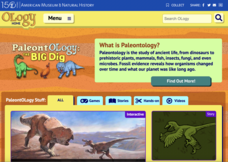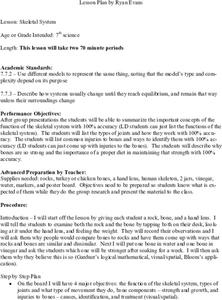Teach Engineering
What Makes Our Bones Strong?
So is that what you meant by rubber legs? The activity has pairs subject a chicken bone to vinegar and observe what happens over a period of days. Individuals then write up a lab report and document their observations and findings.
BioEd Online
Bone Structure: Hollow vs. Solid
What is meant by the phrase "form follows function?" Allow your budding biologists to discover first-hand through two activities. In the first, groups work together to discover whether a solid cylinder or an empty cylinder can support...
Curated OER
What Makes Bones Strong?
Learners explore the function of bone, muscle, and skin. Pasta and rubber bands are used to model how minerals and collagen contribute to bone strength. The effects of the reduction of these substances are explored in chicken bones.
BioEd Online
The Skeleton
Don't be chicken to try a lesson plan that compares the anatomy of birds to humans. Read the background information so you don't have to wing it when it comes to the anatomy of a chicken. Prepare cooked chicken bones by soaking them in a...
Curated OER
Anatomy of Living Bone
High schoolers analyze and examine the anatomy of bones and bone conditions. In this bone anatomy lesson, students analyze and examine the structural properties of bones. They explain the relationship between osteoblasts and osteoclasts...
Curated OER
Bones, Bones, and More Bones
Young scholars describe the functions of bones in the human body. They describe the make up of a bone. They engage in a series of wonderful hands-on activitiies that reinforce learning of bones and the skeletal system.
Curated OER
T's Alive! Or Is It?
Young scholars explore data on the bone, muscle, and skin of living systems and then create a list of characteristics of these systems and relate these characteristics to bone, muscle, and skin.
Curated OER
Skeletal System (Continued)
Students examine human bones. In this skeletal system lesson, students review the functions and locations of bones in the human body. Students work in groups to complete an activity where they discover why bones are hollow and discuss...
Curated OER
Moving and Growing
Students explore the types of skeletons in various animals. For this skeletal systems lesson, students watch a video clip about skeletons, view a human skeleton, compare the skeletons of humans, chickens and fish, and learn about...
Curated OER
Bone Thickness
Students calculate the relative thickness of limb bones in five different species. They relate this to the strength and functions of the limbs by comparing and contrasting the values calculated from the bone measurements. They work in...
American Museum of Natural History
Anatomy Adventure
Sometimes science is puzzling. Using an online animation, individuals manipulate skeletal bones of an ancient species to recreate its skeleton. Learners complete the skeletal puzzle and learn about the process of paleontology in person...
Curated OER
Minerals
Students define the characteristics of a mineral. In this geology lesson, students are given out various materials to observe such as a chicken bone, salt shaker, white paint, and chalk. Students categorize the items and are told what...
Curated OER
Skeletal System
Seventh graders explore the functions of the skeletal system. They collaborate in small groups to determine the function of the skeletal system, the types of joints and movement, bone strength and growth, and bone injuries including...
Curated OER
Skeletal System
Learners discuss the need for humans to have a skeletal system and what would happen if we did not have bones. In this skeletal system lesson, students label each bone in the human skeletal system as a group, and then...
Curated OER
Architecture of the Skeleton
Students experiment with skeletons. In this bone health lesson, students analyze, construct, and perform comparative investigations with bones. They make inferences about the structure and function of various bones. This lesson includes...
Curated OER
Bones and Muscles
Third graders are introduced to bones as the body's means of support and protection. They research bone facts and conduct an experiment with chicken bones. They identify and observe involuntary muscles at work.
Curated OER
ACTIVITY 6: MAKE A FOSSIL MOLD AND CAST and ACTIVITY 7: HOW BIG WERE PREHISTORIC ANIMALS?
Instructions for two terrific ancient history lessons for your primary paleontologists are provided in this resource. The first involves the creation of fossil cast replicas using plaster of Paris. The directions are detailed, but the...
Curated OER
What is the Evidence for Evolution?
Students identify one object that would tell the story of their lives. In groups, they determine what can and cannot be told from objects left behind. After watching a video, they compare and contrast chicken bones to human bones. To...
American Museum of Natural History
What Do You Know About T. Rex?
There's so much to learn about dinosaurs. A 10-question quiz tests knowledge of the more detailed characteristics of the Tyrannosaurus Rex. As individuals complete the quiz, they better understand how fossil records helped define some of...
Curated OER
Marine Habitats of Galveston Island
Four lessons introduce elementary ecologists to salt marsh and sandy beach habitats. In the first lesson, they place shells and other materials in vinegar to determine if they contain calcium carbonate. In the second lesson, they read a...
Curated OER
The Shape of Things
Sixth graders read and discuss information regarding the shape and attributes of an eggshell. In this shape of things instructional activity, 6th graders gather relevant information that pertains to the incubation and formation of an...
Curated OER
A Lucky Break
Students complete activities where they identify and decipher common phrases that are related to poultry and then cook drumsticks as a class. In this poultry lesson plan, students also read the history of the chicken and create idioms.
Curated OER
The Magic School Bus Flexes Its Muscles
Students learn along with Ms. Frizzle's class. In this Magic School Bus lesson plan, students explore the inside of the human body as they compare the bones and joints of a chicken wing with their own hands and arms.
Curated OER
Testing Fats in Food
Students consider the fats found in foods. In this science lesson plan, students test the presence of fat in foods and become more aware of their daily diets.























